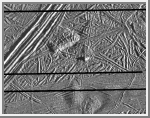|
COMETS EARTH JUPITER KUIPER BELT MARS MERCURY METEORITES NEPTUNE OORT CLOUD PLUTO SATURN SOLAR SYSTEM SPACE SUN URANUS VENUS ORDER PRINTS
PHOTO CATEGORIES SCIENCEVIEWS AMERICAN INDIAN AMPHIBIANS BIRDS BUGS FINE ART FOSSILS THE ISLANDS HISTORICAL PHOTOS MAMMALS OTHER PARKS PLANTS RELIGIOUS REPTILES SCIENCEVIEWS PRINTS
|
Related Document
Download Options
This picture of Europa, a moon of Jupiter, was obtained on February 20, 1997, by the Solid State Imaging system onboard the Galileo spacecraft during its sixth orbit around Jupiter. The area is centered at 9.3 degrees north latitude, 275.7 degrees west longitude, on the trailing hemisphere of Europa. As Europa moves in its orbit around Jupiter, the trailing hemisphere is the portion which is always on the moon's backside opposite to its direction of motion. The area depicted is about 32 kilometers by 40 kilometers (20 miles by 25 miles). Resolution is 54 meters (59 yards). The Sun illuminates the scene from the right (east). A section of a triple band crosses the upper left of the picture and extends for hundreds of miles across the surface. Triple bands derive their name from their appearance at lower resolution as a narrow bright band flanked by a pair of darker bands. At the high resolution of this picture, however, the triple band is much more complex and is composed of a system of ridges 6 kilometers (4 miles) across. Some ridges reach heights of about 180 meters (200 yards). Other features include a hill in the center of the picture about 480 meters (500 yards) high. Two mounds about 6 kilometers across (4 miles) are seen in the bottom of the picture. The ridges, hills and mounds probably all represent uplifts of the icy crust of Europa by processes originating from the interior. |
